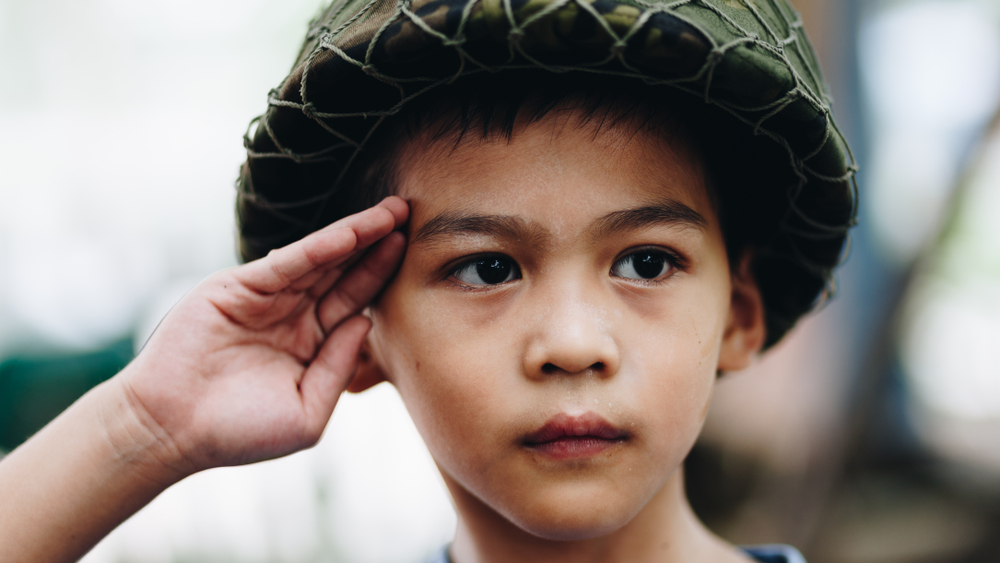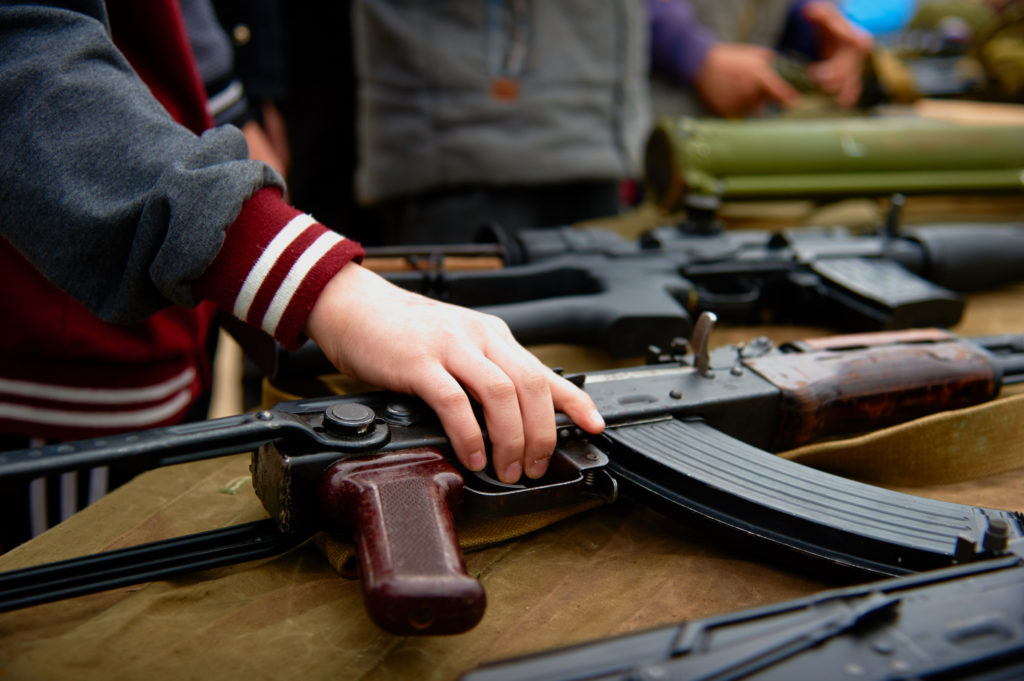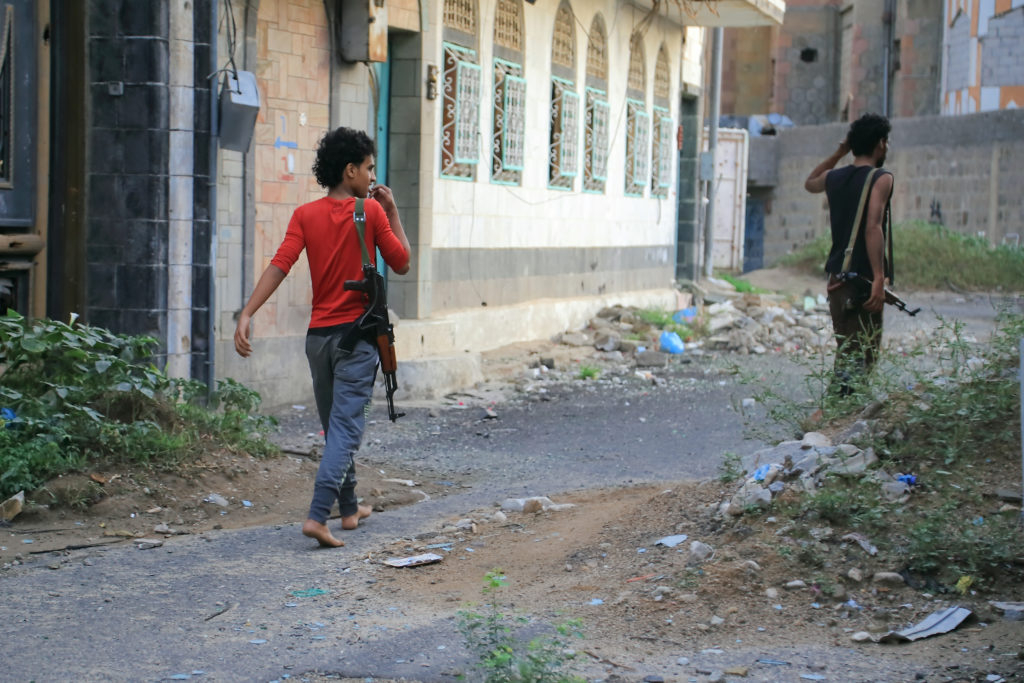A child soldier is any person below the age of eighteen who is forcibly recruited to participate in armed conflicts. These children find themselves caught up in wars unexpectedly and unfairly often due to factors such as poverty, violence, or lack of education. As victims of this grave violation, child soldiers not only endure the same traumas as adult soldiers but also suffer the loss of their childhood and thus become many times irretrievably disconnected from society.

Understanding the issue of child soldiers
Coercion stands as one of the most haunting methods used to recruit underaged soldiers. Threats, psychological manipulation, and intimidation are employed to force children into military service. According to the United Nations, an estimated 40% of child soldiers are coerced into joining armed groups through fear, intimidation, or threats against themselves or their families (United Nations, n.d.)
Furthermore, some children are forcibly abducted from their homes, schools, or communities, forcefully torn away from their families, and thrust into the horrors of armed conflicts. The fear and trauma experienced during these abductions scar the children for life. Tragically, reports indicate that up to 20% of children are abducted against their will, according to the International Criminal Court (United Nations, n.d.)
Child soldier recruitment thrives in poverty-stricken communities, where desperation and lack of opportunities consequently leads to them being exploited. Impoverished families struggling to survive are more susceptible to promises of economic support and a way out of destitution. The vulnerability of these communities contributes significantly to the recruitment of militant minors. Disturbingly, studies reveal that children from the poorest households are more than twice as likely to be recruited compared to their wealthier counterparts, according to UNICEF (United Nations, n.d.)
Consequences and challenges faced by underage soldiers
In 2020, the United Nations reported that “8,521 children, some as young as six years old, had been recruited as child soldiers in the previous year” (World Vision, 2021). These children are exposed to unimaginable atrocities, forced to witness and participate in violence, endure sexual exploitation, and suffer physical and emotional abuse. The scars left on their lives are deep and lasting, and impact them both physically and psychologically.

The consequences of their involvement in armed conflicts extend beyond the immediate dangers they face. The children are denied their right to education, do not have access to the safe space a healthy classroom environment guarantees. This loss of education not only deprives them of knowledge and skills but affects their dreams of a better future. Reports have shown boys and girls feel a sense of hopelessness as they see their chances for job opportunities and a brighter tomorrow fade away. (World Vision, 2021).
Moreover, the toll on their social and personal identities is immense. These children are taken from their homes, and even countries, leaving behind the familiar bonds and connections that shaped them. The resulting isolation further exacerbates their plight, as they struggle to find their place in a world torn apart by conflict. Adding to the complexity of the situation, children may face pressure from elders, leaders, families, or parents to join armed groups, often driven by a desperate quest for protection or misguided support for a cause (World Vision, 2021).
Militant minors undergo profoundly challenging circumstances that can result in mental health conditions such as PTSD, depression, anxiety, and dissociation. PTSD, known as Post-Traumatic Stress Disorder, emerges when an individual encounters a distressing event and struggles to manage the associated memories. This can manifest as heightened fear, confusion, and anger, subsequently impeding their ability to engage in their typical daily activities.
These psychological effects can persist into adulthood, significantly impacting their life trajectories. Additionally, reintegrating into society can pose additional difficulties as they grapple with feelings of guilt, shame, and a loss of identity. The stigma and rejection they face from their communities further compound their psychological burdens (D’Alessandra F, n.d.).
Efforts to combat the use of child soldiers
Treaties and conventions are designed to safeguard children during armed conflicts by explicitly prohibiting their recruitment or involvement in hostilities. For instance, the Convention on the Rights of the Child (1989) states that parties involved in a conflict must take practical steps to prevent children under the age of fifteen from directly participating in warfare and should not recruit them into the armed forces. The Convention defines a child as any person under the age of eighteen unless the national law states otherwise. Additionally, the International Criminal Court (1998) categorizes enlisting children in the armed forces as a war crime (ICRC, n.d.).
Many countries, including Côte d’Ivoire, Nigeria, Cameroon, Somalia, and Chad, have enacted national Laws of Armed Conflict that prohibit the recruitment of children under the age of eighteen (ICRC, n.d.). However, despite these legal provisions, the reality is different. West and Central Africa have the highest numbers of minor soldiers globally, with over 21,000 children recruited by government forces and armed groups in the past five years, according to UNICEF.
Furthermore, more than 2,200 children have been confirmed as victims of sexual violence, and around 3,500 children have been abducted, making the region the second-highest in abductions worldwide (Al Jazeera, 2021).
Addressing the root causes and prevention

Preventing child soldiers requires a comprehensive approach. Firstly, enforcing laws is essential. Countries must pass and rigorously enforce laws explicitly prohibiting recruitment. Equally important is holding perpetrators accountable. Those who recruit or use children in armed conflict must face legal consequences for their actions. Addressing the root causes is also vital. Factors like poverty, lack of education, and social exclusion make children vulnerable. Therefore, tackling issues through poverty alleviation, educational initiatives, and social inclusion programs can help decrease the likelihood of children being coerced into armed groups (United Nations, 2017).
Education plays a pivotal role in conflict-ridden areas by serving as more than just a means of knowledge transfer. It becomes a powerful tool for breaking the cycle of violence, fostering reconciliation, and promoting understanding among conflicting sides. In order to make a meaningful impact, it is crucial to establish inclusive and equitable education programs that specifically cater to the unique needs of children affected by conflict, with a special focus on girls and marginalized groups (Macfarlane K, 2018).
The healing process for underaged soldiers is a complex and lengthy journey. Regardless of how they were recruited or their roles in conflicts, these children are victims who endure profound physical and emotional consequences. Many witness death, killing, and sexual violence, while others are forced to commit violent acts themselves, resulting in severe long-term psychological damage. The reintegration of child soldiers into civilian life is a hard but crucial step needed for their recovery and rebuilding of their lives (United Nations, n.d.)
Lastly, collecting data and documenting instances of child recruitment is crucial. Reliable systems must be established to gather accurate information to raise awareness and develop evidence-based policies. By promoting cooperation among governments and international bodies, sharing best practices, and coordinating efforts, the practice of child soldiers can be addressed on a global scale.
In order to give these children a chance to rejoin the community, it is important to invest in these systems and plans to help communities rebuild themselves following conflict (United Nations, 2017).
Written by Lidija Misic
Internally proofread by Aditi Partha
Last updated on 5 August 2023
Bibliography:
Al Jazeera (2021), World’s highest child soldier numbers in West, Central Africa. Retrieved from AlJazeera at https://www.aljazeera.com/news/2021/11/23/world-highest-child-soldier-numbers-in-west-central-africa-un, accessed on May 21, 2023.
D’Alessandra Federica (n.d.), The Psychological Consequences of Becoming a Child Soldiers: Post-Traumatic Stress Disorder, Major Depression, and Other Forms of Impairment. Retrieved from Harvard University at https://carrcenter.hks.harvard.edu/files/cchr/files/dalessandra_pshychol_cons_of_childsoldiers.pdf, accessed on May 20, 2023.
ICRC (n.d.), Practice relating to Rule 136. Recruitment of Child Soldiers. Retrieved from The International Committee of the Red Cross at https://ihl-databases.icrc.org/en/customary-ihl/v2/rule136#:~:text=Article%2050%2C%20second%20paragraph%2C%20of,or%20organizations%20subordinate%20to%20it%E2%80%9D., accessed on May 21, 2023.
Macfarlane Kate (2018), Child soldiers and reintegration: The social-political complexities of return. Retrieved from Yale Fox International Fellowship at https://foxfellowship.yale.edu/sites/default/files/files/2020%20files/Macfarlane%20-%20Final%20PB.pdf, accessed on May 21, 2023.
United Nations (n.d.), Child Recruitment and Use. Retrieved from United Nations Office of the Special Representative of the Secretary-General for Children and Armed Conflict at https://childrenandarmedconflict.un.org/six-grave-violations/child-soldiers/, accessed on May 20, 2023.
United Nations (2017), Ending the Use of Child Soldiers. Retrieved from United Nations Office of the Special Representative of the Secretary-General for Children and Armed Conflict at https://childrenandarmedconflict.un.org/2017/02/ending-the-use-of-child-soldiers/, accessed on May 21, 2023.
United Nations (n.d.), The Six Grave Violations. Retrieved from United Nations Office of the Special Representative of the Secretary-General for Children and Armed Conflict at https://childrenandarmedconflict.un.org/six-grave-violations/, accessed on May 20, 2023.
World Vision (2021), Child soldiers: What you need to know. Retrieved from World Vision at https://www.wvi.org/stories/child-protection/child-soldiers-facts-and-foundations, accessed on May 20, 2023.

